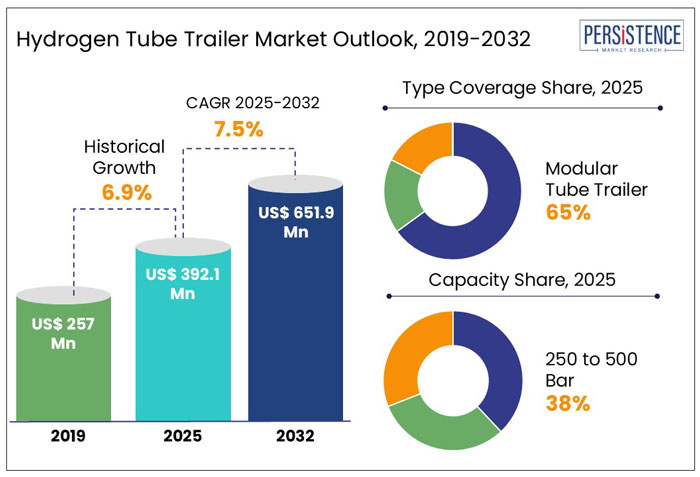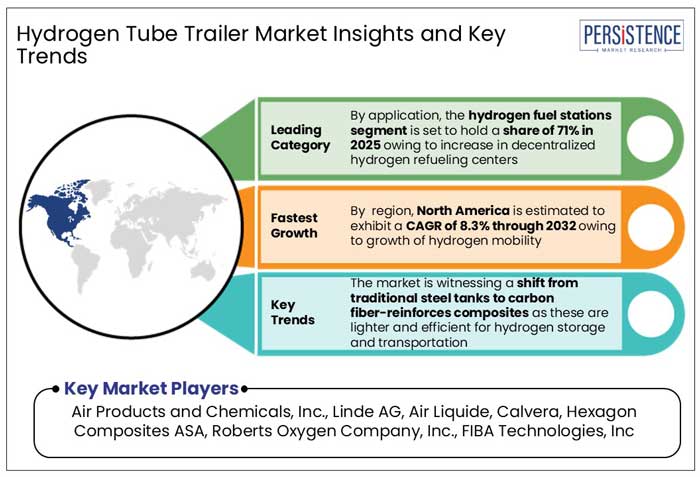Industry: Energy & Utilities
Published Date: February-2025
Format: PPT*, PDF, EXCEL
Delivery Timelines: Contact Sales
Number of Pages: 188
Report ID: PMRREP35124
The global hydrogen tube trailer market is predicted to reach a size of US$ 392.1 Mn by 2025. It is anticipated to witness a CAGR of 7.5% during the forecast period to attain a value of US$ 651.9 Mn by 2032.
According to Persistence Market Research (PMR), hydrogen infrastructure is witnessing increasing investments, thereby fueling growth. Industries are adopting hydron fuel for transportation owing to its environmental benefits. For example,
Rising focus on decarbonizing industries is further driving demand for green hydrogen transportation. Hydrogen refueling infrastructure is booming, with North America, Europe, and Asia Pacific leading in terms of growth.

Key Highlights of the Industry
|
Global Market Attributes |
Key Insights |
|
Hydrogen Tube Trailer Market Size (2025E) |
US$ 392.1 Mn |
|
Market Value Forecast (2032F) |
US$ 651.9 Mn |
|
Projected Growth (CAGR 2025 to 2032) |
7.5% |
|
Historical Market Growth Rate (CAGR 2019 to 2024) |
6.9% |
Hydrogen Gained Traction as a Part of Gren Recovery Strategies from 2019 to 2024
The hydrogen tube trailer market growth was steady at a CAGR of 6.9% during the historical period from 2019 to 2024. In the early development phase, adoption of hydrogen was in its nascent stage, with limited hydrogen infrastructure. For instance,
Despite disruptions caused by the COVID-19 pandemic, hydrogen gained attention as part of green recovery strategies. For instance,
Introduction of innovative tube trailer designs with 500+ bar capacity further boosted growth. The number of hydrogen stations increased to 540 worldwide, augmenting high demand for tube trailers.
Policies Supporting Decarbonization are Predicted to Accelerate Investments through 2032
The hydrogen tube trailer industry is anticipated to exhibit a CAGR of 7.5% through 2032. Manufacturers are working on the development of lightweight and high-capacity tube trailers for efficient hydrogen storage and transport.
Global policies supporting decarbonization are likely to accelerate investments in hydrogen, including subsidies for hydrogen infrastructure. Establishment of hydrogen refueling stations are predicted to be key drivers. Innovations in technology like carbon-fiber tube materials are likely to enhance growth.
Growth Drivers
Growth of Hydrogen Infrastructure Amid Need for Clean Energy Sources to Spur Demand
As hydrogen becomes a critical clean energy source, countries are extending their hydrogen refueling station networks. For instance,
By 2030, industry forecasts estimate the installation of more than 10,000 hydrogen stations globally to meet rising hydrogen demand. Extension of hydrogen fueling infrastructure directly supports the surging adoption of hydrogen fuel cell vehicles. For example,
Hydrogen tube trailers are critical for delivering hydrogen to refueling stations and industrial facilities in regions without direct pipeline access. For example,
Alternate Transporting Solutions like Pipelines to Gain Impetus due to Cost-effectiveness
The hydrogen tube trailer industry faces significant competition from other methods of transporting hydrogen. Hydrogen pipelines are dedicated pipelines used to transport hydrogen gas over long distances. These are considered the most economical and efficient method of transporting hydrogen over land, particularly in regions with large-scale hydrogen production plants and storage facilities. For instance,
Investments in Hydrogen Mobility Solutions Create Avenues with Carbon Neutrality Norms
Hydrogen mobility refers to the use of Hydrogen-Powered Vehicles (HPVs), including Fuel Cell Electric Vehicles (FCEVs), trucks, buses, and trains. These vehicles offer a zero-emission alternative to traditional fossil-fuel-powered vehicles, making them crucial for achieving carbon neutrality. For example,
The EU is also aiming for 5,000 hydrogen refueling stations by 2030, which will require substantial hydrogen transportation infrastructure. For instance,
With countries aiming for net-zero emissions by 2050, hydrogen mobility is seen as a key element in achieving transportation decarbonization. Governments worldwide are implementing policies and regulations that support the development of hydrogen mobility. This includes tax incentives, subsidies for purchasing hydrogen-powered vehicles, and grants for building refueling infrastructure.
Type Coverage Insights
Modular Tube Trailers Gain Traction Due to Ability to Optimize Loading and Unloading Times
Modular tube trailer is projected to hold a share of 65% in 2025. Modular designs enable easy configuration adjustments based on hydrogen storage and transportation needs. This makes them ideal for small and large-scale operations.
Modular trailers’ ability to adapt to different pressure ranges and hydrogen capacities appeals to industries with varying requirements. These can be easily connected or disassembled, which optimizes loading and unloading times.
Modular design decreases operational and maintenance costs by enabling repair and replacement of specific sections instead of the entire trailer system.
Modular tube trailers can accommodate pressure ratings of up to 500 bars. This meets the demand for high-pressure hydrogen transportation.
Capacity Insights
Steel Companies Prefer 250 to 500 Bar Capacity Backed by Cost Reduction and Safety Features
250 to 500 bar is anticipated to hold a share of 38% in 2025. This capacity range provides a practical solution for both medium- and high-volume hydrogen transportation. It ensures safe and efficient delivery for industrial, energy, and mobility applications without compromising safety standards.
Industries such as chemical manufacturing and steel production prefer hydrogen delivered at pressures between 250 to 500 bar, as it eliminates additional compression costs. This compatibility is fostering demand as refueling infrastructure continues to rise globally. For example,
Regulatory bodies in North America and Europe have set standards favoring hydrogen transportation within this pressure range due to its optimal balance between safety and capacity. Government incentives and funding for hydrogen infrastructure are prominently focused on technologies supporting 350 to 500 bar storage and transport.

Supportive Government Norms to Develop Hydrogen Infrastructure Propel North America
The hydrogen tube trailer industry in North America is estimated to hold a share of 38% in 2025. The U.S. and Canada have announced new hydrogen infrastructure expansion plans, including hydrogen refueling stations and distribution networks. For instance,
Federal policies like the Infrastructure Investment and Jobs Act (IIJA) and the Inflation Reduction Act (IRA) provide billions in incentives for hydrogen production, storage, and distribution. North America is witnessing an increase in hydrogen-powered commercial vehicles, particularly in heavy-duty trucking, which requires reliable hydrogen distribution networks. For example,
The U.S. Department of Energy's Hydrogen Hubs Initiative includes plans for key hydrogen production and distribution hubs in California, Texas, and the Midwest. These hubs will likely require extensive transportation infrastructure, including tube trailers.
Petrochemical and Electronics Manufacturers in Asia Pacific to Spur Demand with Clean Energy Transition
Asia Pacific hydrogen tube trailer market is predicted to hold a share of 26% in 2025. Countries like China, Japan, and South Korea have established new hydrogen strategies to promote clean energy adoption. For example,
Robust steel, petrochemical, and electronics sectors in Asia Pacific are adopting hydrogen as a clean energy source. It is being transported to remote industrial locations using tube trailers to reduce emissions and energy costs. For example,
Rising Green Energy Initiatives like National Hydrogen Strategy to Augment Europe
Europe hydrogen tube trailer market is anticipated to generate a share of 27% in 2025. The region has a high demand for hydrogen from the steel, chemical, and heavy industries as they seek decarbonization solutions. For example,
Government authorities across several countries in Europe are implementing stringent policies and green energy initiatives to fuel growth. For example,
Projects like the Hydrogen Backbone Initiative aim to create an interconnected hydrogen pipeline across 21 countries in Europe, where tube trailers will likely serve as critical interim transportation solutions.
Companies in the hydrogen tube trailer market are investing in research and development to enhance performance, efficiency, and safety of their hydrogen transport systems. They are developing innovative high-pressure cylinders and improving hydrogen storage materials to increase storage capacity and reduce weight.
Businesses are also focusing on leak-proof designs, unique valves, and safety mechanisms to ensure secure transportation. They are incorporating sensors and digital monitoring systems in trailers for real-time tracking of pressure, temperature, and safety conditions during transit.
Manufacturers are further collaborating with governments and private entities to build or enhance hydrogen fueling stations and transportation networks. They are also working with automotive manufacturers to ensure the seamless delivery of hydrogen for fuel cell vehicles, especially as demand for hydrogen mobility rises.
Recent Industry Developments
|
Report Attributes |
Detail |
|
Historical Data/Actuals Forecast Period |
2019 - 2024 2025 - 2032 |
|
Market Analysis Units |
Value: US$ Bn/Mn, Volume: As applicable |
|
Geographical Coverage |
|
|
Segmental Coverage |
|
|
Competitive Analysis |
|
|
Report Highlights |
|
|
Customization and Pricing |
Available upon request |
By Type Coverage
By Capacity
By Application
By Region
To know more about delivery timeline for this report Contact Sales

The market is anticipated to reach a value of US$ 651.9 Mn by 2032.
Trailer tubes are considered one of the best hydrogen carriers.
North America is anticipated to emerge as the leading region with a share of 38% in 2025.
Prominent players in the market include Air Products and Chemicals, Inc., Linde AG, and Air Liquide.
The market is predicted to witness a CAGR of 7.5% throughout the forecast period.